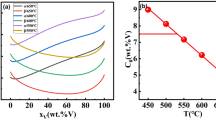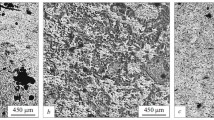Abstract—
This paper considers the main trends of structure formation in graded composite materials based on the Ti3AlC2 MAX phase on titanium under combustion and high-temperature deformation conditions in the unconfined self-propagating high-temperature synthesis compaction method. We demonstrate that a compact graded composite material can be obtained in tens of seconds in one processing step at relatively low pressures (50 MPa). Varying the delay time before applying pressure, we can control the structure and mechanical properties of the resulting composite material. The largest number of carbide grains are formed in the upper part of the material. As the titanium layer is approached, the number of such grains decreases, which is accompanied by an increase in the number of platelike MAX phase grains. We have studied mechanical characteristics of the synthesized materials: variation of microhardness along the height of the composite material and its modulus of elasticity and bending strength.



Similar content being viewed by others
REFERENCES
Shiryaev, A.A., Nochovnaya, N.A., Antashev, V.G., and Alekseev, E.B., Future prospects and special issues in the application of modern sparingly doped high-strength titanium alloys, Tekhnol. Legkikh Splavov, 2013, no. 2, pp. 29–35.
Kablov, E.N., The strategic directions in the development of materials and materials processing technologies until 2030, in Aviatsionnye Materialy i Tekhnologii, Moscow: Vseross. Inst. Aviatsionnykh Materialov, 2012, pp. 7–17.
Oryshchenko, A.S., Leonov, V.P., and Mikhailov, V.I., Titanic efforts: on the sixty years of the development of titanium technologies in Russia, Innovatsii, 2017, no. 7 (225), pp. 7–10.
Golovkin, P.A., Valiakhmetov, S.A., and Fesenko, S.A., Future prospects in improving the reliability of articles from titanium alloys in aerial vehicles, Tekhnol. Met., 2011, no. 9, pp. 16–21.
Oryshchenko, A.S., Leonov, V.P., Rtishcheva, L.P., Kopylov, V.N., and Martynov, K.G., Current status of the production and application of titanium alloy pipes in nuclear power engineering and shipbuilding, Titan, 2018, no. 3 (61), pp. 21–32.
Rahmani, R., Antonov, M., and Kollo, L., Wear resistance of (diamond–Ni)– Ti6Al4V gradient materials prepared by combined selective laser melting and spark plasma sintering techniques, Adv. Tribol., 2019, paper 5415897.
Bai, H., Zhong, L., Shang, Z., et al., Microstructure and mechanical properties of TiC–Fe surface gradient coating on a pure titanium substrate prepared in situ, J. Alloys Compd., 2019, vol. 771, pp. 406–417.
Nasakina, E.O., Sudarchikova, M.A., Sprygin, G.S., Baskakova, M.I., Fedyuk, I.M., Bespamyatnova, A., Borisov, N.I., Danilova, E.A., Sevost’yanov, M.A., Grigorovich, K.V., and Kolmakov, A.G., Effect of flow geometry on the growth of a protective titanium surface layer with the use of magnetron sputtering, Aktual’nye Vopr. Mashinoved., 2018, vol. 7, pp. 294–296.
Agzamov, R.D., Tagirov, A.F., and Ramazanov, K.N., Influence of ion nitriding regimes on diffusion processes in titanium alloy Ti–6Al–4V, Diffus. Defect Data,Pt. A, 2018, vol. 383, pp. 161–166.
Wu, F., Zhou, W., Han, Y., et al., Effect of alloying elements gradient on solid-state diffusion bonding between aerospace aluminum alloys, Materials, 2018, vol. 11, paper 1446.
Magnus, C., Cooper, D., Sharp, J., et al., Microstructural evolution and wear mechanism of Ti3AlC2–Ti2AlC dual MAX phase composite consolidated by spark plasma sintering (SPS), Wear, 2019, vol. 438, paper 203013.
Xu, L., Zhu, D., Grasso, S., et al., Effect of texture microstructure on tribological properties of tailored Ti3AlC2 ceramic, J. Adv. Ceram., 2017, vol. 6, no. 2, pp. 120–128.
Drouelle, E., Joulain, A., Cormier, J., et al., Deformation mechanisms during high temperature tensile creep of Ti3AlC2 MAX phase, J. Alloys Compd., 2017, vol. 693, pp. 622–630.
Zhang, Z., Duan, X., Qiu, B., et al., Preparation and anisotropic properties of textured structural ceramics: a review, J. Adv. Ceram., 2019, vol. 8, no. 3, pp. 289–332.
Benamor, A., Hadji, Y., Chiker, N., et al., Spark plasma sintering and tribological behavior of Ti3SiC2–Ti5Si3–TiC composites, Ceram. Int., 2019, vol. 45, no. 17, pp. 21781–21792.
Averichev, O.A., Prokopets, A.D., and Stolin, P.A., Structure formation in Ti/Ti–Al–C layered ceramic materials obtained by the method of unconfined SHS compaction, Refract. Ind. Ceram., 2019, vol. 60, no. 2, pp. 219–222.
Author information
Authors and Affiliations
Corresponding author
Additional information
Translated by O. Tsarev
Rights and permissions
About this article
Cite this article
Prokopets, A.D., Konstantinov, A.S., Chizhikov, A.P. et al. General Trends of Structure Formation in Graded Composite Materials Based on the Ti3AlC2 MAX Phase on Titanium. Inorg Mater 56, 1087–1091 (2020). https://doi.org/10.1134/S002016852010012X
Received:
Revised:
Accepted:
Published:
Issue Date:
DOI: https://doi.org/10.1134/S002016852010012X




